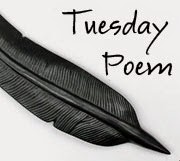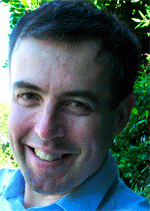The pleasure and stability of dining rooms had always occurred against the catastrophic background of universal chaos. Groups of friends, rooms, streets, years, none of them would last. The illusion of stability was created by a concentrated effort to ignore the chaos they were embedded in. And so they ate, and talked, and enjoyed each other's company … (Kim Stanley Robinson, Red Mars, p. 651)
The sign at the road end says 45 minutes, so we bank on an hour and a half. The day as we set out is still and fine but not warm, and a low line of cloud to the south tells us that the forecast change in the weather will eventually come.
Though my earliest memories of walking are of trips to Oreti Beach or Te Wae Wae Bay, of playing on the beach while my father skimmed stones across the water and my mother sat in the car with her book and the picnic basket, in later life I have developed a preference for walking in the bush. That's like the London Underground: long minutes moving through a tunnel beneath a dimly seen roof, sudden ascents into the light to see how far you've come. Here, at the beach, there is only the slow procession of foot after foot, the thought that, perhaps, the destination, marked by a trio of pyramidal rocks on the horizon, has come a little closer.
Our seven year old son sets off at a rush, foraging ahead of us until I have to remind him that this is a farm track as well as a people track, that a truck or a farm bike might happen along, and to please look where he's going. Five minutes later, he's standing with his arms up, wanting to be carried. Not yet, I tell him, I'll only carry you on the way back. We talk about where to have lunch. Kay thinks we should stop by that square rock in the distance. "It's an awfully long way away," he says.
Progress cannot be measured by the sea, but it can by the land. We've crossed the bridge over the Orongorongo River — there's tramping country somewhere up that valley, they say — and we are walking at the foot of drought-brown coastal hills. Five thousand years ago, the weather here was mild, moist and drought-free, and the hills were clad in a mixed podocarp-beech forest, more like South Westland than the South Wairarapa. But the climate changed, becoming colder and drier, and then sheep were loosed on the land. It was all downhill once the brittle greywacke of the hills had been exposed to the elements.
I like to know things, or at least, to believe that I know them. Ever since moving to Wellington, I would (if pressed) have ventured the opinion that nothing around these parts could match the beauty, grandeur, or sheer natural abundance of Otago and Southland. A few ruddy rocks and a wind turbine just couldn't compare.
Then Kay went to one of BAM Bookshop's periodic sales and bought Reading the Rocks: A Guide to Geological Features of the Wairarapa Coast. I read it and got all enthusiastic. Here, no more than two hours' drive away, were all manner of wonderful things: rocks like giant sails, pinnacles bizarre enough to play a leading role in a Peter Jackson film, and one of the finest collections of raised beach ridges in the world at Turakirae Head, which is where we're going today.
We've packed the appropriate Field Guide (six of which were nestled in a handy pocket at the back of Reading the Rocks), so the next time our son says he's tired, I get a snack bar and Field Guide Six out of my backpack and show him where we've got to. "Look, there's an alluvial fan!", I say, and he looks with gratifying attention at the deep gully and the fan of scree that has washed out of it.
We're quite near the lunch rock now. A man returning from Turakirae Head tells us that we're only ten minutes' walk away from the Head itself, where the coast curls round into Palliser Bay, but after an hour slogging over that gravel we're ready for a rest. Gratefully, we walk to the seaward side of the rock, where a hollow provides protection against the breeze, and sit down to eat.
How did this rock get here? It came from the hillside above us, maybe down the alluvial fan. One dark night, or one bright day, it broke free of the hillside and rumbled down to where we now sit in its shelter. Though it looks solid enough, and warms our backs as we rest against it, it is a mayfly in the lens of time.
What are we and our rock sitting on? It takes some squinting at Reading the Rocks to make that clear. Our rock shows up distinctly on the aerial photo, just before the point where the farm track branches off from the coast track, and we see that we are on the fourth of five beach ridges. The youngest ridge, just behind the shoreline, was raised 2.5 metres by the 1855 earthquake. The ridge we're sitting on was raised during the Haowhenua earthquake, around 1500 AD.
Five hundred years ago, then, the solid ground where we now sit would have been a beach, washed by the tide, pounded by the southerly swell. If our lunch rock had been in its present position then, the sea would have broken on its flanks.
Thank you, Kay, for making the filled rolls and packing the cake. They were delicious. Thanks for buying the book, as well. We sit by the rock and chew slices of apple, as the memory of the waves washes this phantom shore.
Nothing lasts, not the places we sit to dine, not rooms, not streets, not years. The next earthquake could come today, tomorrow, next year. Our rock might be raised further above sea level then, or it might be shaken to pieces. From far away, it looked as solid as, well, a rock. Close up, it's showing the cracks. It's no more safe than houses. We tidy up the lunch things, hoist our packs onto our shoulders, and walk on.


